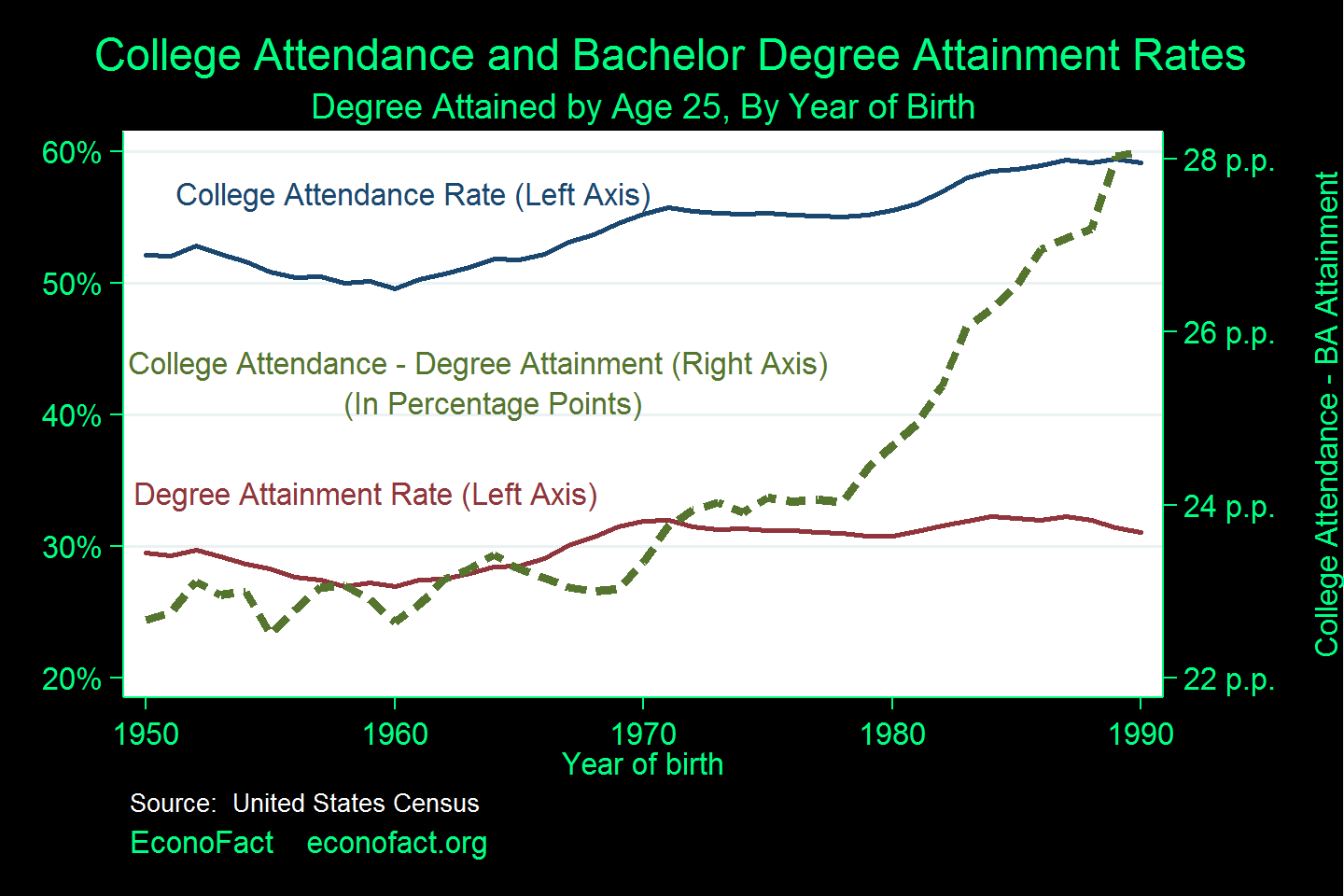The Diploma Gap: Growing Costs of an Unfinished College Education
Harvard Kennedy School and Harvard Graduate School of Education
The Issue:
College attendance rates have risen steadily for three decades, despite increasing college costs. However, college completion rates have flatlined. Students who drop out before obtaining a college degree are missing out on the higher earnings and improved employment opportunities available to college graduates. In many cases, they are also exiting college saddled with debt.Degree completion rates are lowest in the regional and local public colleges that have been hardest hit by declining state funding.
The Facts:
- While U.S. college attendance rates have steadily increased over the past three decades, the percentage of students completing a bachelor’s degree by age 25 has not improved. The share of students who were likely to have attended college by age 25 was higher for the cohort born in 1990 than for those born in 1970; however the share of those who had completed college by 25 remained fairly steady at about 30 percent (see chart). Completion rates in two-year institutions actually declined from 30.5 percent to 27.9 percent between 2002 and 2014, according to data from the U.S. Department of Education. Although the share of first-time, full-time, first-year students in bachelor’s degree programs who completed degrees within six years grew modestly from 55.4 percent to 59.6 percent during the same period, this rate is smaller than what would be expected given the increase in college attendance. The lack of improvement in college completion rates follows a trend of lengthening times to achieve a degree between the 1970s and 1990s.
- The problem of low college completion is particularly pronounced for low-income and minority students. Currently, only 30 percent of first-year undergraduate Pell Grant recipients — who receive student aid based on demonstrated financial need — complete a bachelor’s degree within six years of entering college. College completion rates also have been lower among minorities. For example, in the 2008 college entry cohort, only 41 percent of African American students and 53 percent of Hispanic students graduated from bachelor’s degree programs within six years, compared to 63 percent of white students.
- College dropouts are much more likely to default on their student loans. Among federal student loan borrowers who entered repayment in 2011-2012, 24 percent of those who left school without a degree or certificate defaulted on their loans within two years, compared with 9 percent of those who completed their program, according to a 2016 report by the College Board. Among students who expect to earn a four-year degree, the 38 percent who do not earn their degree after six years have borrowed an average of $7,413 in student loans. If you only look at the students who took out loans and did not complete the degree, the average loan burden is even higher: $14,457, according to the same study. While loan burdens are generally higher for students who complete their degree, such loans are easier to pay off when a student completes college. Thus high college dropout rates and growing student debt burdens are closely connected.
- There is a growing body of evidence that higher institutional spending can increase degree completion rates. State and local funding for public institutions has historically allowed them to provide a higher quality education than is reflected by the prices charged to students. The extra spending per student helps to provide a better quality education by allowing for smaller classes and better instruction, as well as by facilitating other student supports such as counseling and tutoring. Lower public subsidies per student are associated with lower college completion rates. For instance, researchers have found that when states have larger cohorts of college students it takes students longer to complete their degrees and college completion rates are smaller. Similarly, Christopher Walters and I find that state budget cuts to higher education have a large negative impact on postsecondary attainment. Several studies have found that increasing student support services, including mentoring, tutoring and counseling, can raise graduation rates. For instance, an evaluation of ASAP, a program at the City University of New York that provided a full range of supports including comprehensive advisement, career services and tutoring, found that the program nearly doubled graduation rates in the students who participated.
- State funding for education per student has declined over the past several decades. Total state appropriations for higher education in the U.S. grew by less than 4 percent between 1990 and 2015, while full-time equivalent enrollment increased 45 percent over the same period, according to data compiled by the State Higher Education Executive Officers Association (SHEEO). The decrease in spending per student means that some public institutions have larger classes and have cut services, all of which contribute to lower graduation rates.
What this Means:
The U.S. has a college completion crisis. Degree completion rates are lowest in the regional and local public colleges that have been hardest hit by declining state funding. Over time, funding cuts have led to these colleges having fewer full-time instructors, larger classes and less academic support for students. A growing body of research suggests that increasing per-student spending increases degree completion. Yet Federal and state policy focuses mostly on lowering college costs, not increasing institutional spending. We should rebalance public subsidies for higher education to support spending increases, not just price cuts.
Like what you’re reading? Subscribe to EconoFact Premium for exclusive additional content, and invitations to Q&A’s with leading economists.

